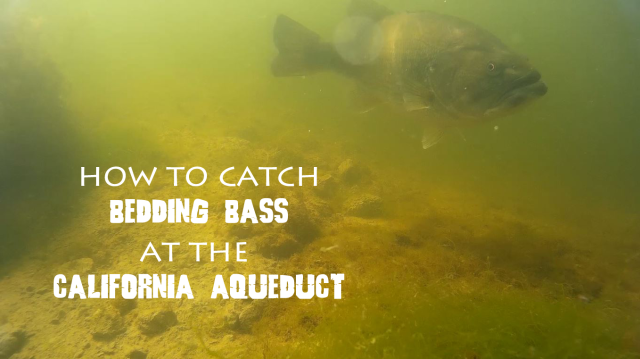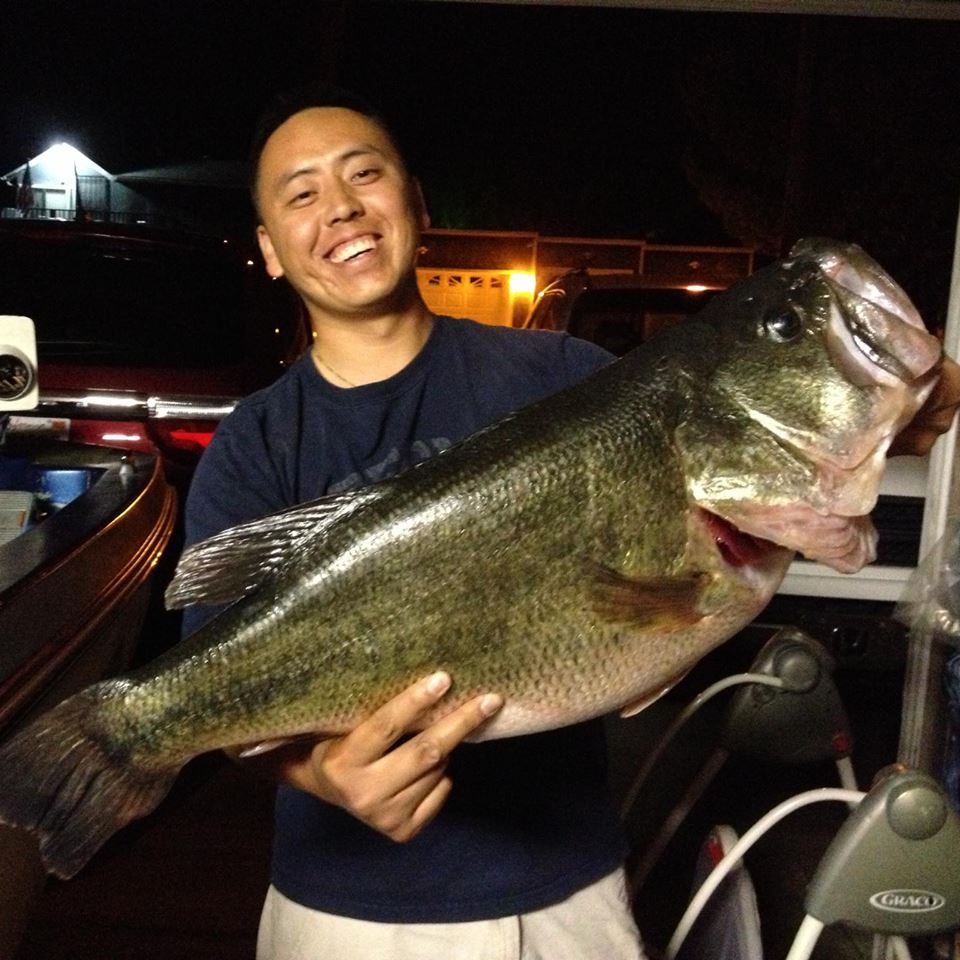
FishAholics: How To Catch Bedding Bass At The California Aqueduct
Fishing for bedding bass can be one of the most exciting times during the year. We are visual creatures. When we can see and react to a fish taking our lure, that definitely stimulates our senses. When we miss that strike, many anglers scream out words of unpleasant poetry. It’s also the time the big girls come out from their deeper haunts and hangout in the shallows. Today, I want to show you how to fish for bedding bass right here at the California Aqueduct. Unlike most lakes and reservoirs, it has no natural structure or cover. So they’ve adapted in a unique way in this concrete river.
When Do Bass Spawn At The California Aqueduct
Bass usually begin to spawn in late February. Not all bass will spawn at the same time. I have found some to spawn in late May as well. You will find many bass shallow and sitting on their beds for the next few months. Some bass at the California Aqueduct have timed they’re spawning habits to coincide with the heavy weed growth. Weeds grow and cover most of the aqueduct walls seasonally. The eggs need direct sunlight to hatch. The bass have learned to spawn before the weed growth becomes too thick to allow sunlight to seep through in order for the eggs to hatch. That also means they will spawn sooner in the southern regions than their northern counter parts.
The weeds generally begin taking over the duct walls late April to early May. A week or two after this, you will notice fish fry swarming around the newly formed weedline. The male bass that were supposed to protect these young have disappeared to their deeper haunts. A natural protective babysitter provided by mother duct. This makes the California Aqueduct a prime fishery for bass because their young can thrive here without the need for a parenting fish to protect them.
The Moon Factor
I have noticed more big bass bedding near the first full moon of spring. Which is about late February to early March. There are some areas with high concentration of big bass. I’m talking about several 5 lbers to near trophy sized bass within a two mile stretch of water. I think this is a direct result of less pressure from anglers (most people target striped bass here) and a healthy eco system. I can safely say that this is one place that can benefit from anglers taking home their catches more often than not.
Getting Started
When bass are bedding, they do not forage or eat at all. Their primary goal at this point is to mate and protect the eggs or hatchlings. When you’re out fishing for bedding bass, they’ll hover over a nest. You’ll also notice them chasing away other fish that roam nearby. Fishing for bedding bass is an art. Each fish behaves differently. You’ll have some that dart off the moment they see you. There are some that will sit on the nest but seem to have lock jaw. Some will strike at or take your bait as soon as it hits the water. It’s a game of patience and perseverance.
The Gear
When fishing for bedding bass, one thing that’s just as important as your fishing rod is a good pair of polarized sunglasses. Without one, you will miss the majority of the bass through the glare of the sun or disturbance on the water’s surface. So don’t leave home without one.
To fish for bedding bass, a medium heavy rod with a strong backbone should do the trick. With this type of fishing, you aren’t casting blindly to a location, in fact, you are sight fishing, hunting for these fish. I would recommend braided line, preferably 30-65lbs. You don’t want the line to stretch. When you set the hook, you want an instant hook set.
Bait
When fishing for bedding bass, ANY lure can work. Unless the fish is very protective; I’ve found slower moving baits to work the best. I personally like to use a bottom fishing bait such as a jig or fluke. You can imitate a creature on the bottom actively feeding on the eggs. When provoked, the bass will simply engulf your lure or try to carry it to the nest edge.
Bass Behavior During The Spawn
All bass behave differently during the spawn. This is because they are all at different stages of the spawn. Some may be looking for a bed to start spawning, others may have no eggs to guard yet and others maybe guarding their nest aggressively. Who knows? You have to assume they’ll dart off the moment they see you. Sneak up on them and throw that bait at them. Here are just a few examples of the bass behaviors you’ll encounter.
The Spitter
Most of these bedding bass get spooked easily in the earlier stages of the spawn. Some might not have eggs yet so they are less committed to protecting the nest. They’ll stare at it, tease you by nibbling the bait and spitting it out. For these kind of bass, I like to use a skirted ¼ oz jig head paired with a white beaver trailer. This will give it a slower fall. It also presents a smaller profile. I also like to do something different when I use smaller jig heads. I hook the beaver trailer a little more in the rear to create a bend in the bait. This will give it a flipping action when twitched. You’ll see what I mean in the video. Sometimes this erratic action gives it just the right umph for a strike and hook set.
The Active Bass
I like to throw a heavier skirted 3/8 to ½ ounce jig head sometimes. I will pair this with a white plastic beaver trailer. I like using white because it shows well below and above water. You have to remember, these fish are not actively feeding. They just want to get rid of that bait you’re throwing at them. If the fish is active, it will strike at it the moment it hits the bottom. You will know it’s an active fish because the moment the bait falls, the bass will swim towards it. I’ve had a few that will strike the jig as it’s falling to the bottom. These types of bass are not readily available for the taking but when you find them, they are some of the most exciting to catch.
Hit Em Up
So if you’ve fished for bedding bass before, you know how tough it can be sometimes. A bigger profile bait can spook them the moment it enters the water. Sometimes you just have to switch things up. I love using jigs but sometimes the good ol’ fluke gets the job done when all else fails. As soon I switched to the fluke, it paid more interest to the bait. That alone wasn’t enough to catch it though. If you can’t get the fish to bite you have to provoke it to strike. How do you do this you ask? Well, nudge or make contact with the fish using your lure. As you can see in the video, the moment I made contact…well, see for yourself.
Locked Jaw
Sometimes the fish just won’t bite. It’s almost like they are on a mission. That mission is to lock their mouth shut and throw away the key. These types of bass are what I consider the “I’ll get you next time” type of bass. If they’re not biting today, eventually they’ll come to. Go back the next day or two and their mood just might change. After all, they’re not going anywhere anytime soon.
Where To Find Spawning Bass At The California Aqueduct
Bass do not like current when they spawn. Unlike stripers that need current to keep their eggs a float before hatching, black bass need their eggs anchored down. Often the best locations are places that will allow them to be shielded from fast moving current. The following are just a few of the potential locations where you can find them.
Isolated Pockets Of Weed Growth
During the earlier stages of the spawning season, most of the weed growth on the duct walls isn’t that pronounced. Some areas will have more weed growth than others. Find these isolated pockets of weed growth and the chances of finding them bedding down current is very likely. The more isolated, the better. These areas are great for bedding bass for two reasons. It provides cover from predatory fish that may feed on the eggs. It blocks the water current from carrying the eggs or young juveniles away.
A good start would be to find places where weeds can latch onto or anchor their roots down. Cracks on the duct walls, ladders, sandbags or grates can provide such places. Explore and you’ll find new places that will work for you.
Cutouts
I’ve mentioned these locations before in the past but with good reason. Fish use these as a home year round because it’s great for two things: cover and as an ambush point. During the spawn, it provides a place to hide and a break from the current.
These are permanent structures along the aqueduct. They won’t go away seasonally like weeds. They are easier to target but will also get more pressure. Here’s a clip I captured from a cutout along the duct walls. As you can see, it creates a perfect environment for bedding bass. A flatter bottom, break from current and shields out potential predators. This shot was taken during pre spawn. This bass was not locked onto her bed yet so she wasn’t aggressive enough to take a strike at my lure. It was very interested in my camera. I think most bass are just curious by nature.
Wall of Weeds
Weeds will start to line the aqueduct walls as the weather begins to warm. The southern ducts will show signs of this first. It will slowly progress north as the water warms up. Bass will setup their nest between the weedline and the shoreline. They need direct sunlight in order for the eggs to hatch. So, you won’t find many of them bedding underneath foliage. They also require the eggs to be able to latch onto the bottom. You can go an entire stretch and not find a single bedding bass. There are some locations where they are so concentrated, there will be bedding bass every 10 yards or so. But generally they will be between the weedline and the concrete wall.
Conclusion
So next time you see that bass hovering over a bed, think about what kind of bass it it maybe. If it doesn’t bite the first time, keep at it. Persistence pays off. So what type of bedding bass are you fishing for?
Like what you read? Sign up for the FishAholics Newsletter below and get exclusive content that you cannot find here on the blog, as well as details about how you can land yourself a 14lb largemouth bass. Sign up to hear my story. [mc4wp_form]


great read and videos… persistence and element of surprise.
Thanks Days Yang. Very few bass actually take the bait on the first few tries. You gotta keep at it.